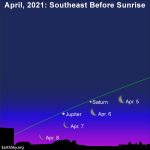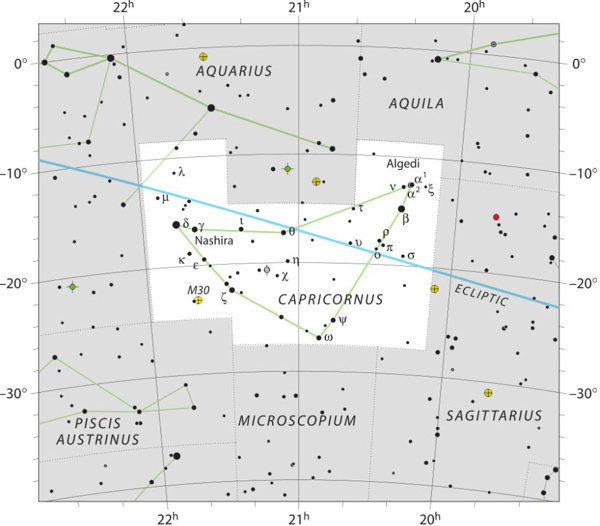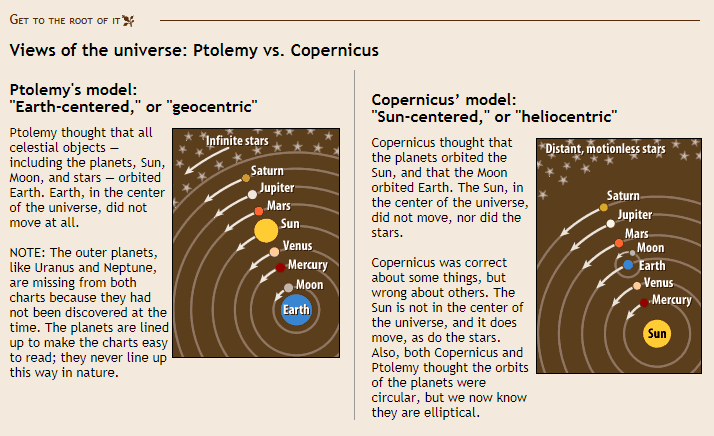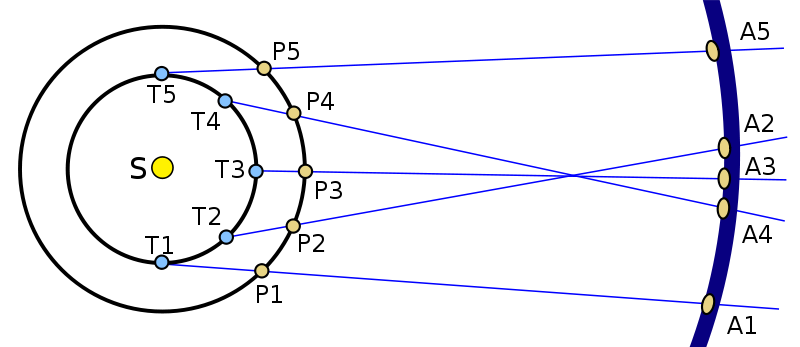
On April 5, 6, 7 and 8, 2021, let the waning crescent moon help guide your eye to the largest and second-largest planets of the solar system: Jupiter and Saturn, respectively. Because day by day the moon always travels eastward (in the direction of sunrise) relative to the backdrop stars (and planets) of the zodiac, watch for the moon to sweep past Saturn and then Jupiter in the days ahead.
Find out which constellations of the zodiac appear behind the moon at Heavens-Above.
At present, the king planet Jupiter and the ringed planet Saturn both reside in front of the constellation Capricornus the Seagoat. Jupiter and Saturn, the fifth and sixth planets from the sun, respectively, also go eastward in front of the background stars of the zodiac, but much more slowly than the moon does. Whereas the moon takes some 27 1/3 days to go full circle in front of the constellations of the zodiac, it takes Jupiter nearly 12 years and Saturn nearly 30 years.

View a larger chart. | Have a birthday sometime between January 20 and February 16? If so, the sun was probably in front of the constellation Capricornus on your birthday. This year, 2021, you can use the planet Saturn to locate Capricornus all year long!
The moon will pass out of the constellation Capricornus and into the constellation Aquarius after several days. But Jupiter won’t pass into the constellation Aquarius until April 25, 2021. Saturn, the most distant world that you can easily see with the eye alone, will remain in front of the constellation Capricornus for the rest of the year. In short, Jupiter stays in front of a constellation for about one year, while Saturn does so for about 2 1/2 years.
Find out which constellation of the zodiac lies behind Jupiter and Saturn at Heavens-Above.
In one year, Jupiter travels around 30 degrees eastward yearly in front of the backdrop stars of the zodiac, while Saturn travels about 12 degrees eastward yearly. Ancient astronomers correctly figured that Saturn must lie farther away from Earth than Jupiter does because Saturn moves more slowly in front of the constellations of the zodiac. In this respect, ancient astronomers were correct.
Because the ancients were such acute observers, they observed the retrograde (westward) motions of the superior planets: planets that orbit the sun outside Earth’s orbit (Mars, Jupiter and Saturn). However, the ancients had great difficulty coming up with a model that could adequately explain these mysterious retrogrades. That’s because the ancients, for the most part, were led astray by the presumption that the planets orbit the Earth, instead of the sun.

Contrasting Ptolemy’s Earth-centered model with Copernicus’s sun-centered model. In the Earth-centered model (left), Mercury and Venus orbit the sun inside the sun’s orbit around Earth. In the sun-centered model (right), Mercury and Venus orbit the sun inside Earth’s orbit. Graphic via Amazing Space.
The moon always travels eastward in front of the constellations of the zodiac, yet never in retrograde. On the other hand, the superior planets – Mars, Jupiter and Saturn – go eastward overall, yet display mysterious retrograde motions from time to time. Moreover, the superior planet always shines most brilliantly in Earth’s sky at the middle of a retrograde, at which juncture that planet is at opposition or opposite the sun in Earth’s sky.
The more distant the planet, the longer the retrograde. Because the distances of these worlds vary somewhat as they orbit the sun, so do the lengths of their retrogrades, depending on the year. The approximate retrograde periods: Mars (two months), Jupiter (4 months) and Saturn (4 1/2 months). We give you Jupiter and Saturn’s retrogrades and oppositions for 2021:
Jupiter
Retrograde begins: June 21, 2021
Opposition: August 20, 2021
Retrograde ends: October 18, 2021Saturn:
Retrograde begins: May 23, 2021
Opposition: August 2, 2021
Retrograde ends: October 11, 2021Note: Mars last reached opposition on October 13, 2020, and will next reach opposition on December 8, 2022
The innovative astronomer Copernicus (1473-1543) figured the moon never displays retrograde motion because the moon revolves around the Earth, not the sun. On the other hand, the planets show retrograde motion because all the planets (including Earth) revolve around the sun. When Earth in its smaller and faster orbit swings by a slower-moving superior planet – Mars, Jupiter or Saturn – that planet appears to go backwards for the same reason that a car appears to go backwards (relative to the distant background) when you pass that slower-moving car on the highway. The diagram below helps to explain.
Inferior planets – planets that orbit the sun inside of Earth’s orbit – show retrograde motions as well, but for the opposite reason. When a faster-moving inferior planet – such as Mercury or Venus – sweeps by the slower-moving Earth, Earth appears to retrograde in its sky, and that inferior planet appears to retrograde in ours.

The planets move in a counterclockwise direction as viewed from the north side of the solar system. Relative to the backdrop stars, a faster-moving inner planet sees a slower-moving outer planet moving in retrograde from A2 to A4, and at opposition at A3. Diagram via Wikipedia.
Bottom line: Are you an early riser? Be sure to get an eyeful of the picturesque morning tableau as the waning crescent moon sweeps by the giant planets Jupiter and Saturn from April 5-8, 2021.
from EarthSky https://ift.tt/3sTjwAo

On April 5, 6, 7 and 8, 2021, let the waning crescent moon help guide your eye to the largest and second-largest planets of the solar system: Jupiter and Saturn, respectively. Because day by day the moon always travels eastward (in the direction of sunrise) relative to the backdrop stars (and planets) of the zodiac, watch for the moon to sweep past Saturn and then Jupiter in the days ahead.
Find out which constellations of the zodiac appear behind the moon at Heavens-Above.
At present, the king planet Jupiter and the ringed planet Saturn both reside in front of the constellation Capricornus the Seagoat. Jupiter and Saturn, the fifth and sixth planets from the sun, respectively, also go eastward in front of the background stars of the zodiac, but much more slowly than the moon does. Whereas the moon takes some 27 1/3 days to go full circle in front of the constellations of the zodiac, it takes Jupiter nearly 12 years and Saturn nearly 30 years.

View a larger chart. | Have a birthday sometime between January 20 and February 16? If so, the sun was probably in front of the constellation Capricornus on your birthday. This year, 2021, you can use the planet Saturn to locate Capricornus all year long!
The moon will pass out of the constellation Capricornus and into the constellation Aquarius after several days. But Jupiter won’t pass into the constellation Aquarius until April 25, 2021. Saturn, the most distant world that you can easily see with the eye alone, will remain in front of the constellation Capricornus for the rest of the year. In short, Jupiter stays in front of a constellation for about one year, while Saturn does so for about 2 1/2 years.
Find out which constellation of the zodiac lies behind Jupiter and Saturn at Heavens-Above.
In one year, Jupiter travels around 30 degrees eastward yearly in front of the backdrop stars of the zodiac, while Saturn travels about 12 degrees eastward yearly. Ancient astronomers correctly figured that Saturn must lie farther away from Earth than Jupiter does because Saturn moves more slowly in front of the constellations of the zodiac. In this respect, ancient astronomers were correct.
Because the ancients were such acute observers, they observed the retrograde (westward) motions of the superior planets: planets that orbit the sun outside Earth’s orbit (Mars, Jupiter and Saturn). However, the ancients had great difficulty coming up with a model that could adequately explain these mysterious retrogrades. That’s because the ancients, for the most part, were led astray by the presumption that the planets orbit the Earth, instead of the sun.

Contrasting Ptolemy’s Earth-centered model with Copernicus’s sun-centered model. In the Earth-centered model (left), Mercury and Venus orbit the sun inside the sun’s orbit around Earth. In the sun-centered model (right), Mercury and Venus orbit the sun inside Earth’s orbit. Graphic via Amazing Space.
The moon always travels eastward in front of the constellations of the zodiac, yet never in retrograde. On the other hand, the superior planets – Mars, Jupiter and Saturn – go eastward overall, yet display mysterious retrograde motions from time to time. Moreover, the superior planet always shines most brilliantly in Earth’s sky at the middle of a retrograde, at which juncture that planet is at opposition or opposite the sun in Earth’s sky.
The more distant the planet, the longer the retrograde. Because the distances of these worlds vary somewhat as they orbit the sun, so do the lengths of their retrogrades, depending on the year. The approximate retrograde periods: Mars (two months), Jupiter (4 months) and Saturn (4 1/2 months). We give you Jupiter and Saturn’s retrogrades and oppositions for 2021:
Jupiter
Retrograde begins: June 21, 2021
Opposition: August 20, 2021
Retrograde ends: October 18, 2021Saturn:
Retrograde begins: May 23, 2021
Opposition: August 2, 2021
Retrograde ends: October 11, 2021Note: Mars last reached opposition on October 13, 2020, and will next reach opposition on December 8, 2022
The innovative astronomer Copernicus (1473-1543) figured the moon never displays retrograde motion because the moon revolves around the Earth, not the sun. On the other hand, the planets show retrograde motion because all the planets (including Earth) revolve around the sun. When Earth in its smaller and faster orbit swings by a slower-moving superior planet – Mars, Jupiter or Saturn – that planet appears to go backwards for the same reason that a car appears to go backwards (relative to the distant background) when you pass that slower-moving car on the highway. The diagram below helps to explain.
Inferior planets – planets that orbit the sun inside of Earth’s orbit – show retrograde motions as well, but for the opposite reason. When a faster-moving inferior planet – such as Mercury or Venus – sweeps by the slower-moving Earth, Earth appears to retrograde in its sky, and that inferior planet appears to retrograde in ours.

The planets move in a counterclockwise direction as viewed from the north side of the solar system. Relative to the backdrop stars, a faster-moving inner planet sees a slower-moving outer planet moving in retrograde from A2 to A4, and at opposition at A3. Diagram via Wikipedia.
Bottom line: Are you an early riser? Be sure to get an eyeful of the picturesque morning tableau as the waning crescent moon sweeps by the giant planets Jupiter and Saturn from April 5-8, 2021.
from EarthSky https://ift.tt/3sTjwAo

Aucun commentaire:
Enregistrer un commentaire